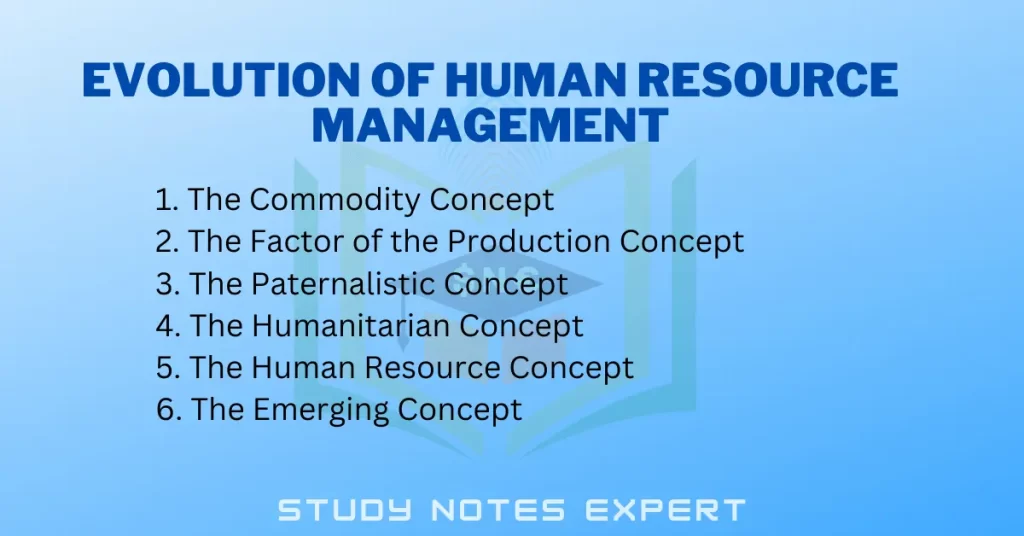In this blog, you will learn about the evolution of human resource management. HRM is the process of management that develops and manages the human element in an enterprise. Human Resource Management (HRM) is a management function that helps managers to find the right man for the right job. Also, there are some recent techniques in HRM that play a crucial role in management.
In other words, HRM is concerned with the people’s dimension in organizations. Every organization is made up of people, and its name in the market is due to the people of the organization. Human Resource Management (HRM) is the function within an organization that focuses on different functions. These are recruitment, management, and providing direction for the people who work in an organization. It is not only the management of the skills but also the attitudes and aspirations of people. In the following section, we will explain the evolution of human resource management.
Also Read: History of Human Resource Management
Evolution of Human Resource Management
The evolution of human resource management has developed through the following Stages.

1. The Commodity Concept
Before the Industrial revolution, the guild system was the beginning of HRM. Guild was a closely knit group concerned with selecting, training, rewarding & maintaining workers. The separation of owners from managers breaks the close relationships between owners & employees. Labor began to be considered a commodity to be bought & sold. Therefore, it is the evolution of hrm.
2. The Factor of the Production Concept
Under this concept, employees were considered a factor of production, just like land, materials & machinery. Taylor’s scientific management stressed proper selection & training of employees To maximize productivity. The employees were treated primarily as operating organizations of machines or as mere appendages in the process of production. However, this concept was an improvement in so far as employers gained through better working conditions and higher earnings.
3. The Paternalistic Concept
Employees organized together based on their shared interests & formed trade unions to improve their lot. The growing strength of democracy gave impetus to collective bargaining. The state also recognized that workers had a right to protection in employment. It is the main evolution of Human Resource Management. Due to all these forces, employers provide different schemes to workers. Employers have a fatherly and protective attitude towards their employees. The welfare schemes included health facilities, recreation facilities, pension plans, group insurance schemes, etc. Employers & employees both began to realize that they cannot survive and prosper without each other.
4. The Humanitarian Concept
Under the paternalistic approach, the employer provides employee benefits as a favor. The humanitarian system is based on the belief that employers have certain Unalienable rights as human beings. It shows the evolution of hrm in India. The employer has to protect these rights. Industrial psychologists pointed out that an employer was not merely interested in material rewards. Instead, social and psychological Satisfaction was equally important. Hawthorne experiments with considerable Interest in human-generated problems in the Workplace. The approach is also known, therefore, as a human relations concept.
5. The Human Resource Concept
Several studies were conducted to analyze & understand human behavior. These studies applied behavioral science to the problems in Individual & group behavior at work. Motivation, Group dynamics, organizational climate, organizational conflict, etc., have become popular concepts. Employees began to be considered valuable assets of an organization. Efforts were made to integrate employees with the organization so the organization’s goals and employees’ could be achieved simultaneously. Focus shifted towards management practices like two-way communication, management by objectives, the role of informal groups, quality circles, etc. It plays a crucial role in the evolution of Human Resource Management.
6. The Emerging Concept
Now, employees are considered partners in the Industry. They are gradually being given shares in the company’s stock membership. Workers’ representatives are being appointed to the board of directors. This emerging trend aims to create a feeling among workers that the organization is their own. Slowly but steadily, HRM is emerging as a particular academic discipline & as a profession with distinction. It is growing as a career with distinct specializations like human resource development, Industrial relations, etc.
Conclusion
In this write-up, we have discussed the complete stages in the evolution of human resource management. HRM began as a record-keeping function. Later on, the administration of labor agreements became its primary task. After some time, the focus shifted to the scientific aspect involving systematic techniques for employee selection, training & Compensation. On the other hand, the emerging concept looks upon them as a resource, an asset & an opportunity.
How Many Stages are there in Evolution of HRM?
The evolution of human resource management has developed through the following 5 Stages.
1. The Commodity Concept
2. The Factor of the Production Concept
3. The Paternalistic Concept
4. The Humanitarian Concept
5. The Human Resource Concept
6. The Emerging Concept
How was the Evolution of HRM in India?
At the beginning of the 20th century, the initial viewpoint was the end of exploitation. As a result, many legal measures were taken by the Government. It gave birth to a vital concept of HRM. Later, developments showed the tendency of a positive attitude toward the welfare of the employees. In a nutshell, the evolution of human resource management helps us identify human resource management as a profession.


I appreciate the clear explanations in this tutorial.